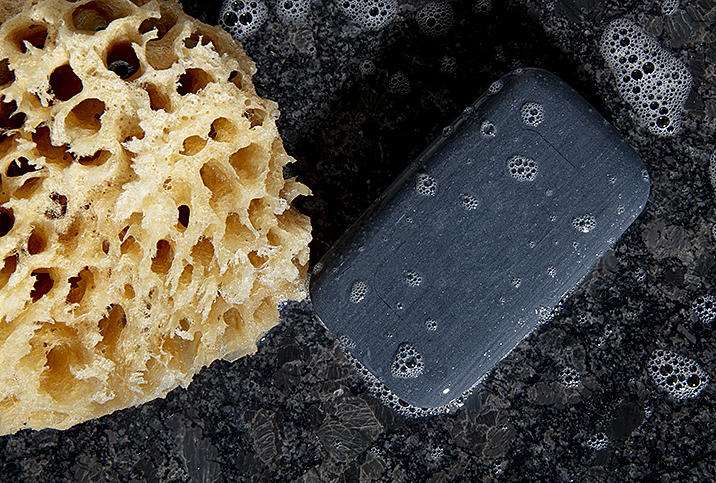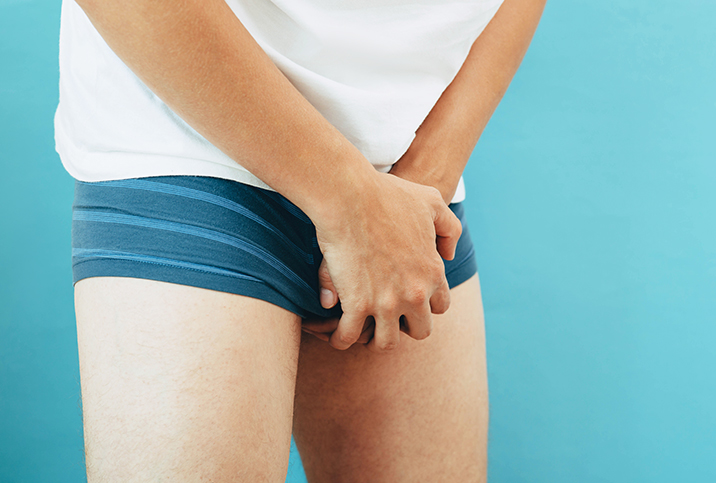Poor Hygiene Does Lead to Balanitis, But It's Not the Only Cause

It should come as no surprise to any guy—or to anyone who has provided sexual pleasure to a man—that the head tends to be the most sensitive part of the penis.
Given this sensitivity, a condition such as balanitis, or inflammation, can be quite uncomfortable, especially if it interferes with erotic pleasure.
"[The inflammation] results in soreness and redness of the penile glans," explained David Yao, M.D., an attending urologist at the David Geffen School of Medicine at the University of California, Los Angeles. "There can also be itching and discharge."
Experts recognize three main types of balanitis: Zoon's, which affects the glans penis (the head) and the foreskin; circinate, which is characterized by small and shallow lesions on the head of the penis; and pseudoepitheliomatous keratotic and micaceous balanitis (PKMB), characterized by scaly and wart-like skin lesions on the glans.
Foreskin and skin folds are predisposing factors
Balanitis is relatively common among people with a penis, especially those uncircumcised. Foreskin can enclose perspiration, exfoliated skin, and bacteria or yeast on the glans penis. Balanitis affects about 3 percent of men who have not had their penile prepuce removed, Yao noted.
His colleague, Jesse Mills, M.D., a professor of urology at UCLA and author of the book "A Field Guide to Men's Health," said someone who is circumcised but obese can also have nominal skin folds that envelop the head of the penis similarly to the way foreskin does on uncircumcised men, and the same inflammatory condition can result.
Chronic irritation or an infection can contribute to the inflammation, Mills added. In addition to the redness and itchiness that often accompanies balanitis, swelling is sometimes present, too, as a result of a focal or fungal infection. Candida, for example, can bring on a bout of balanitis.
"It can burn to pee if it's close to the urethra, but usually it's just unsightly [and] uncomfortable," Mills said of balanitis.
Balanitis affects about 3 percent of men who have not had their penile prepuce removed.
Dead skin cells can become trapped between the foreskin and the glans penis, and the dead skin nourishes the bacteria or fungus responsible for the infection and inflammation, he said.
Minus appropriate hygiene and routine retraction of the foreskin, the buildup of skin, fungus and bacteria leads to inflammation, Yao said. In turn, the inflammation can then make it more difficult to retract the foreskin, Mills added.
Seemingly, the stagnant, microbe-proliferating foreskin associated with balanitis can produce a vicious cycle. Balanitis can result from the failure or inability to pull back the tissue fold enveloping the glans penis, yet can cause the severe tissue constriction and lack of foreskin mobility that might exacerbate and reproduce the condition, which makes underlying causes quite salient to determine.
Elevated blood glucose and immunocompromised status
The prevalence of penile inflammation tends to be greater in patients who are immunocompromised, and men with elevated blood glucose due to diabetes or prediabetes have extra sugar that bacteria and fungus can glom onto, Mills said.
According to Yao, the excess sugar expedites yeast growth, which can negatively affect the health of the penis head.
Uncontrolled diabetes can make the inflammation worse and the condition more difficult to treat. However, Mills stressed that men with diabetes who monitor their blood glucose and take care of themselves are not destined to develop balanitis, just as guys with intact foreskin will not inevitably experience inflammation of the penis head, as long as they practice proper hygiene and skincare.
A connection to STDs and STIs
Yao said chlamydia—a sexually transmitted disease (STD) often accompanied by penile discharge, burning during urination and sometimes swelling of the testicles—can cause glans penis inflammation and irritation, though these are less common symptoms. Other sexually transmitted infections (STIs) can also increase the likelihood a guy's glans penis develops balanitis, and cause similar symptoms, as well.
"Syphilis is coming back with a vengeance, and you can get lesions on the penis that look like balanitis," Mills said. "That can be the chancre of syphilis."
Skin conditions and irritants
Yao noted balanitis can also follow conditions such as psoriasis and contact dermatitis. In a 1993 study involving 43 balanitis patients, 31 also had irritant dermatitis, also known as eczema.
Lichen sclerosus, a chronic disorder that often affects preputial skin and the glans, is also associated with balanitis and synonymously called balanitis xerotica obliterans.
Other concerns
Diseases that affect the heart, liver or kidneys and compel the body to retain water also increase the risk for balanitis, according to Yao.
Mills said cancer, though not a cause, still remains an apropos worry.
"If anybody has any spot on the penis, especially closer to the head of the penis, then there's always a possibility that it's something malignant, and most of the penile cancers start off as things that look more like a genital wart because most penile cancer is caused by the same virus that causes warts: condyloma," Mills said.
Red areas that appear on the head of the penis can turn into precancerous lesions, Mills noted, suggesting early diagnosis and treatment for glans penis inflammation assume additional importance.
Prevention of balanitis
Consistent washing and good hygiene can be preventive actions against balanitis. Mills said circumcised men do not have to do much more than regular showering because there's no place for balanitis to really take hold.
Other preventive measures include cleaning your penis after intercourse, using condoms that fit properly, avoiding potentially irritating detergents or fabric softeners, and washing your hands before touching your genitals.
Mills said staying in decent physical shape can help reduce risk factors such as chronically high blood sugar and excess weight, including abdominal fat, thereby keeping the head of your penis healthy.
Treatment of balanitis
The cause of glans penis inflammation tends to determine the treatment. Balanitis sometimes responds to warm baths and better hygiene.
"You may be prescribed an antifungal cream if the condition was caused by yeast—steroid creams if the balanitis is caused by skin disease or an allergic reaction, or antibiotics for bacterial balanitis," Yao explained. "If there is swelling of the penile glans, soaking the penis in a warm bath with a salt solution is very helpful."
If chronic, uncomfortable inflammation of your glans penis and the wrench it can throw into your sex life doesn't compel you to seek treatment early, a doctor's warning might.
"If it does go untreated, it can cause pretty significant infection, and that infection can even spread to the surrounding skin," Mills said.
You should get evaluated by a doctor if the condition does not improve within two weeks, he added. This will ensure there isn't another underlying problem, and sometimes antibiotics or antifungal medication need to be prescribed.
If it does go untreated, it can cause pretty significant infection, and that infection can even spread to the surrounding skin.
"When balanitis is treated early, there will be lower risks of complications, such as scarring of the foreskin [phimosis] and the urethral meatus [meatal stenosis]," Yao said. "Balanitis can be an early warning sign of diabetes, so it is important to get checked out by a medical professional even if the symptoms resolve at home."
Although balanitis is not an STD, you can transmit the organisms that cause it through sex. Yao suggests men get a professional evaluation for STDs, depending on their sexual history. He also implores men who develop balanitis to let their sexual partners know about it as a courtesy to them and to mitigate against recurrent infections.
If balanitis recurs, uncircumcised men might consider speaking with their doctors about removing the prepuce as a treatment and prophylaxis.
If your balanitis is associated with reactive arthritis, fluid retention or cancer, Yao said you may need to see a doctor who specializes in infectious diseases, joints, the heart, the liver or tumors.


















